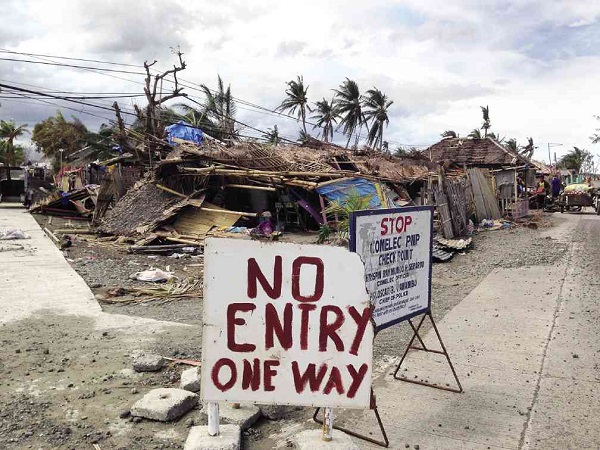
SEVERAL days after the onslaught of Supertyphoon “Yolanda,” residents in New Washington town, Aklan province, struggle to rebuild their homes and their lives. MARICAR CINCO/INQUIRER SOUTHERN LUZON
For 60-year-old Joelino Saldivia, a coconut farmer from Barangay Julita, Libacao town, in Aklan province, Supertyphoon “Yolanda” is a typhoon like no other.
“There are storms that hit us before, but nothing could be compared to Yolanda,” Saldivia said.
Libacao, a fourth-class municipality about 30 kilometers east of Aklan’s capital, Kalibo, is one of the areas worst hit in the province.
A report of the Aklan Provincial Disaster Risk Reduction and Management Council (PDRRMC) said the damage to agriculture in the province was estimated at P454 million and to infrastructure, P191 million, the highest among all 17 affected towns in the province.
Of the 13 reported deaths, seven were residents of Libacao, most of them hit by fallen trees.
Yolanda also damaged about 90 percent of Saldivia’s 3-hectare coconut plantation in the village, which is about 2 km from Libacao’s poblacion.
“Previous storms that hit our village damaged portions of our plantation but this time, Yolanda destroyed our livelihood,” Saldivia said in despair.
Saldivia recalled that the last typhoon that brought much damage in their town was Typhoon “Frank” in 2008.
But compared to Frank that damaged less than 100 of the 300 trees in his plantation, Yolanda destroyed almost everything.
Aklan’s main industry is agriculture and the primary product is coconut.
Of the 17 municipalities in Aklan, Libacao has the second largest coconut plantations at 5,380 ha, next to Ibajay town with 6,012 ha. It also ranks third in terms of copra production, with 2,399 metric tons per year, next to Makato and Balete towns.
Copra is the dried, white flesh of the coconut from which coconut oil is extracted to make crude oil and oil cakes, which is used mostly for livestock feed.
However, due to Yolanda’s destruction, there might be no copra production in Aklan next year, according to Plevy Raco, provincial manager of the Philippine Coconut Authority (PCA).
“The typhoon has greatly affected our coconut industry. This coming 2014, no copra will be produced since our coconut trees were greatly damaged,” Raco said in an interview.
In 2012, Raco said Aklan produced 46,405 metric tons of copra.
Based on the initial report of the PCA-Aklan, of some 4 million coconut trees in the province, the biggest in Western Visayas, 86,687 trees valued at P45.25 million were destroyed and 253,541 trees worth
P39.88 million were heavily damaged with only 25 percent chance of recovery.
Saldivia said they usually harvested at least 2.5 tons of copra and sold them for P15 to P20 per kilo.
“But because of the storm, we don’t know if we still have anything to harvest this coming months,” Saldivia said.
Now, what is visible in their village are coconut trees, some bent, others without leaves, due to the storm.
“These trees are like paralyzed individuals that could no longer bear fruits,” he added. “It might take us three to five years to gain back what we have lost.”
But despite the calamity, Saldivia said their only choice now would be to rise and continue living.
Aside from relief assistance, what they need is the government’s help in restoring their livelihood, Saldivia said.
“I hope the government agencies would provide us coconut seedlings for us to regain what we have lost,” he said.
But while waiting for assistance, Saldivia said all they could do for now was to take care of the trees that were left standing.
“We are still hoping to revive at least
10 percent of our crops. Trees damaged by the storm may be used to help rebuild the houses of our neighbors who have lost their homes,” said Saldivia whose optimism was still reflected by the smile on his face.
Luckily, Saldivia’s house partly made of concrete and light materials survived the storm.
About 300 of 458 households in Julita were damaged by the storm, according to their village head, Gabriel Zaulda. Zaulda said at least 50 houses were destroyed.
A report of the Aklan PDRRMC showed that 47,153 houses were damaged while 37,967 were destroyed in the province. There were also 427,640 affected persons.
Raco, meanwhile, said the PCA would provide livelihood assistance to the affected coconut farmers.
“Aside from providing them new planting materials, we will also provide coconut seedlings for them to start again,” assured Raco.
She added that they were coordinating with the regional office to speed up the assistance for the affected coconut farmers.
However, Raco advised coconut farmers to plant other agriculture products. “Plant other short-term crops like banana, corn, and palay,” she said.